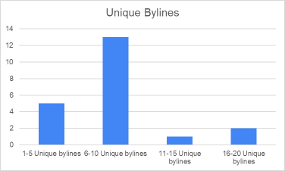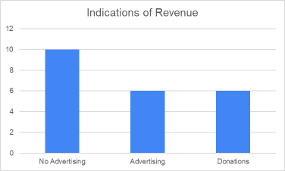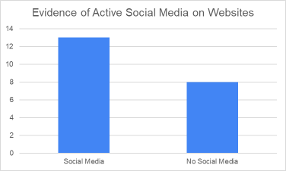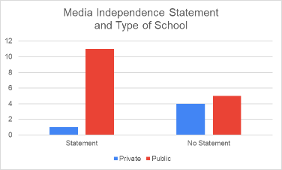Starting a conversation: An exploration of the state of student media websites at Historically Black Colleges and Universities
Abstract
Student media at HBCUs have declined precipitously since 2000 yet provide a significant look at issues meaningful to the Black communities they represent and cover. This study uses content analysis of existing student media websites to assess the state of student media at HBCUs. It finds several notable trends. Frequency of content updates varies, yet student-run news websites are not typically updated daily and are likely updated only when breaking news occurs or when students have new content to post. Stories covering student government or administration were uncommon, and nearly half of the websites did not offer any form of advertising. Medium-sized HBCUs were more likely to have active social media compared to smaller-sized HBCUs, and public HBCUs were more likely to have some form of a media independence statement on their website. These descriptive data provide a starting point for conversations about an important media source and training ground for future Black journalists.
Keywords: HBCU, student media, news websites, content analysis
Legacy news media continue to bleed, with layoffs continuing into 2024 after a 50% rise in layoffs in 2023 (Farhi, 2024). Newspapers still are closing, leaving communities without independent sources of news (Abernathy, 2023; Newspaper Fact Sheet, 2023). College student-run media, which appeared healthy despite the upheaval in legacy media in 2012 (Kopenhaver, 2012; Payne, 2012), now struggle financially post-pandemic, though 94% continued to publish one way or another through the COVID closures (Kopenhaver, et al., 2021).
Through all of this research, the state of student media at Historically Black Colleges and Universities has been largely overlooked. This research provides the first step in filling that gap.
Literature Review
Only recently have researchers turned their attention to Black media generally with the Black Media Initiative at the Craig Newmark School of Journalism at City University of New York (Thompson-Morton, et al., 2021). Student media at HBCUs have attracted the attention of a coalition of news organizations and companies with the ReNews Project, which provides resources to breathe new life into dormant student newspapers at HBCUs and Hispanic Serving Institutions (ReNews Project, n.d.). Research has taken historical looks at HBCU journalism and mass communication programs (Albritton, 2012; Jeter, 2002; LeMelle, 2002; Wilkinson, et al., 2020). It has examined the role of HBCUs in desegregating the news industry in the decades since the Kerner Commission (Sturgis & Johnson-Ross, 2019). One mention of academic research was found on student media at HBCUs. It was completed more than 20 years ago by Reginald Owens, and it was an article summarizing Owens’ work in Black Issues in Higher Education but not a peer-reviewed paper (Stewart, 2000). The only other research was a summer 2023 census of student media at HBCUs and HSIs conducted by one of the authors of this paper in preparation for this research (Norman & Lopez Luritta, 2023).
The two decades out of researchers’ view turned out to be difficult ones for student media at HBCUs. Owens found in 2000 that 69% of the 100 HBCUs that responded had active student media, and he bemoaned the fact that only 11 of those, or 16%, published weekly. The rest, it was noted, published monthly or less often (Stewart, 2000). A census of student media at HBCUs done in the summer of 2023 found a much bleaker landscape: only 38 HBCUs, or 36% of the 107 total listed in The Hundred Seven, a website dedicated to tracking HBCUs, even had active student media (Norman & Lopez Luritta, 2023). The 2023 research did not attempt to determine frequency of publication, but the research found decline of nearly half of active student media at HBCUs.
The census of student news outlets at HBCUs and HSIs (Norman & Lopez Luritta, 2023) took a step further, comparing 2023 student media with those listed in the 2017 Editor & Publisher Newspaper Databook (E&P, 2017). This comparison found 35 student newspapers at both HBCUs and HSIs opened between 2017 and 2023, but only 4 of those were at HBCUs, well below the replacement rate of 18 that had closed in those years. Some 30 student media outlets at HSIs had closed in those six years but had been replaced by 31 new student news organizations. The glimmer of good news for student media at HBCUs was that during the conference where this research was presented, editors of Spelman College’s The Blueprint showed off their publication, which had been newly revived with the help of the ReNews Project. This brought the total number of student media at HBCUs to 39 as of Fall 2023.
Significance
The state of student media at Historically Black Colleges and Universities deserves special attention. A student editorial in The Lincoln University’s Lincolnian in Pennsylvania noted that broader media cover crises at predominantly white institutions, such as shootings, scandals involving faculty or administration, protests or controversies over diversity, equity and inclusion, but such events are not covered at HBCUs. This lack of coverage harms HBCUs by reinforcing negative stereotypes, perpetuating the false narrative that they are inferior, and this inhibits fundraising efforts and reduces potential advocacy that might change policies and the false narrative with it (Page, 2023).
Beyond that, Black Media Matters, a content analysis of Black media in the United States, finds that Black media cover issues important to Black communities six times more than mainstream media, and it does so with a racial, global and historical context missing in the mainstream media (Thompson-Morton, et al., 2021). Student media at HBCUs, by extension, shed light on institutions important in the Black community. The precipitous decline in the number of student media outlets at HBCUs combined with the important role they could play give this research significance.
Research Question
This research uses content analysis to explore student media at HBCUs with this research question: What is the state or current landscape of college media at Historically Black Colleges and Universities?
Methodology
To answer the above research question, examine the current state of college media at HBCUs, and explore indicators of health of the publications, a content analysis was conducted of all current HBCU student media websites in the United States. This analysis was done in two steps. The first included 39 HBCUs identified from the database provided by Norman & Lopez Luritta (2023). Of those available, 6 did not have currently functioning websites, meaning the sites no longer existed or had not been updated in more than a year. Those sites were considered ineligible, leaving 33 websites that had been updated within the 2023-24 academic year. This was a pilot to inform the researchers’ work in terms of operational definitions and coding procedures.
Using data and experience from the first round, the second step included only websites that had been updated after April 1, 2024, to capture websites that were active at the end of the school year. Content and bylines from the past 30 days were included, though in cases when the last content was posted in April, content published before April 1 was not included for methodological consistency. In this second round, 18 websites had no new content before April 1, and the remaining 21 were included for coding.
Before either round of coding, descriptive information was gathered from the 2015 College Blue Book (Romaniuk, 2015), the most recent available to researchers, for all 39 HBCUs with student media. This descriptive information included location, size of school, type of institution (two-year college, four-year college or university), and presence of a communication, media or journalism program. College size was then coded as either small (enrollment fewer than 5,000), medium (enrollment 5,000-15,000) or large (enrollment more than 15,000) based on the classification system used by collegedata.com.
In the first round, coders recorded the following information about the 33 student media websites: date of last apparent update, frequency of regular updates, number and types of stories from the past week, number and types of stories from the past month, number of unique bylines from the past month, presence and status (active or inactive) of social media accounts, types of advertising shown, indication of e-newsletter, masthead information (number and contact information) about the staff, language about editorial independence and founding newspaper year.
Three coders divided the websites and coded them within a two-week window. The coders reviewed and discussed the coding categories, previewed a sample of college newspaper websites and practiced the coding scheme. The coders worked independently and coded sets of websites using a Google form, which was exported to an Excel spreadsheet for further analysis. No reliability was attempted in this discovery phase. It was designed to take a first look at the websites and determine appropriate variables.
In the second round, two coders recorded data independently from each of the 21 student media websites that had been updated since April 1. The variables were reduced to the following: number of unique posts; number of posts on student government; number of posts on administration or board of trustees; number of unique bylines; number of students listed on the staff page; sources of revenue; whether the student media appeared to be active on social media; and whether the website had a statement of student media independence.
Initial intercoder and intracoder reliability on the number of unique posts was below the desired 90% level because of the categories the researchers tried to capture. To address this, the two coders went through the websites together to count only unique content and ended up with 100% reliability, using simple percent agreement method. According to Wimmer and Dominick, published content analyses require a minimum reliability coefficient of 90% or above (2014). The coders decided to include all content, multimedia such as podcasts and non-journalistic such as poetry, as well as traditional news and feature stories. Student government and administration/board of trustee-related posts started with reliability of 95.24% and 80.95% respectively from independent coding. After reviewing the differences, the coders ended up with 100% reliability. In the case of administration-related content, one coder was counting obituaries of former administrators while the other was not; they decided to include obits. The number of unique bylines and students listed somewhere on the website had initial agreement of 33% and 66.67% from independent coding. The coders resolved these differences together; often a coder double counted a student’s byline or missed a page where student staffers were listed. Revenue sources started with 76.19%, active social media at 90.48%, and presence of an independence statement at 100%. The differences were resolved so that all variables ended with 100% agreement for all 21 websites.
Results
Phase One Analysis
In the first round, where 33 functioning student news websites were analyzed, we categorized 23 of these covering small institutions, 10 as medium-size institutions, and none as large institutions. Among these institutions, 26 were public and 6 were private. Additionally, we discovered that 25 institutions offered programs in journalism, media, or communication, while 7 did not.
Of the 33 news websites analyzed, 7 were updated less than monthly, 6 monthly, 7 two to three times a month, 6 weekly, and 7 two to three times a week. We found in the second round of coding that it was difficult to determine how often websites were being updated from a 30-day sample, so this variable was eliminated in the second round.
Coders found 11 websites had been updated not at all or only once in the past 30 days. Another 11 had been updated 8 or more times. The remainder had posted new content 2 to 7 times. Most of those stories were features and only 2 were about student government while 1 covered an administration issue. We also analyzed the number of unique student bylines. The findings here were similar to those of new content in the past 30 days. Eleven websites had no or only 1 unique student byline, 11 had 8 or more unique student bylines, and the remainder had 2 to 7. This informed our decision to eliminate websites that had not been updated in the past 30 days in the second round.
Eight of the 33 websites offered a link to the student media’s corresponding print content on Issuu or a related website. Because we found some student media on Issuu independent of a link from the website, we decided to eliminate this as a variable in the second round.
The majority of websites included social media links on their pages. Of them, 22 of 33 contained a variety of social media links. Instagram was the most common with Twitter as the second most common. The variation in the types of social media that were active prompted us to consolidate this as a single variable: active social media account.
E-newsletter sign-up options were available for 9 of the 33 websites. This variable was eliminated in the second round. On the masthead or About Us page, 13 included names of editors, and 5 contained contact information for student staff. Of the websites, 18 offered general contact information and 10 had names of faculty or staff advisers. This variable was retained in the second round of coding of the 21 student media websites updated in the past 30 days.
Phase Two Analysis
Of the 21 websites coded in step two of the study, the average number of unique content posts in the past 30 days was 10, with websites ranging from 1 to 31 posts. All of the websites posted some type of content within the code period, with a mode of 10 websites posting 6-10 stories. A total of 4 websites posted 1-5 stories, 4 websites showed 11-15 stories, 2 websites had 16-20 stories and 1 website contained more than 20 stories.
Stories posted about student government were uncommon. Of the 21 websites, 14 had no posts about student government issues, 5 websites had 1 post, and 2 websites had 2 stories about student government issues. Similarly, 15 of the 21 websites posted zero stories about administration or trustees, 5 websites had 1 story, and 2 websites contained 1 story about administration or trustee issues.
The average number of unique bylines was 8 per website, with websites ranging from 1 to 19 unique bylines. A mode of 13 websites posted 6-10 bylines. Five websites contained 1-5 unique bylines, 1 website contained 11-15 bylines, and 2 websites showed 16-20 unique bylines.
Of the 21 websites, 10 contained no advertising, 6 contained advertising of some type (third party, local, national or sponsored content) and 6 indicated donations as a source of revenue. One website indicated both advertising (through sponsored content) and donations.
While 8 of the 21 websites coded did not contain evidence of active social media, 13 of them did indicate some social media activity. A post hoc analysis creating a cross tabulation of active social media activity with school size indicates that the majority of schools with no social media were small. No large schools were coded.
| Cross tabulationSocial media evidence and school size | ||
| Small School | Medium School | |
| Social Media | 6 | 7 |
| No Social Media | 7 | 1 |
Number of students listed on the staff page of the websites was coded and revealed a mode of 9 websites that had zero staff members listed. There were 7 websites that listed 1-10 members, 2 websites showed 11-20 staff members, and 1 website in each of the remaining categories of 21-30, 31-40 and more than 41.
| Number of students listed on the Staff page | |
| 0 students | 9 websites |
| 1-10 students | 7 websites |
| 11-20 students | 2 websites |
| 21-30 students | 1 website |
| 31-40 students | 1 website |
| 41 and more | 1 website |
Websites were coded for the presence of a statement on student media independence. Of the 21 websites, 9 did not include any language on editorial independence and 12 did have some kind of statement. When broken out into a cross tabulation for public or private school, some differences emerge. Of the schools that contained some type of language asserting media independence, 11 of the 12 were public schools. Of those that did not include some type of statement, schools were fairly evenly split with 4 private schools and 5 public schools. For example, Alabama State University, a public institution, wrote on The Hornet Tribune website under Core Values, “We have been the independent student voice of Alabama State University since 1879. None of our content is influenced by the university administration or anyone else outside of our staff.”
Discussion
This was an exploratory study to inform future research on the health of student media at Historically Black Colleges and Universities. The researchers started out with some assumptions about media health that this stage of the research brought into question. We assumed that news websites would reflect the work of the newsroom, but the fact that just over half of the student media identified had news websites updated within the last 30 days of the semester challenged that premise. We assumed that the number of unique content and unique bylines would indicate health, but if the news website is not a priority for the newsroom, especially in smaller newsrooms with limited resources, then health for the broader population of student media at HBCUs must be measured another way. We do feel confident that this exploratory work has provided some insight that will inform future research.
Number of stories posted in 30 days.
When analyzing the number of unique posts from these student news websites, we found that nearly 50% of them posted 6 to 10 unique articles over a 30-day period. This suggests that these student-run news websites are not updated daily and are likely updated only when breaking news occurs or when students have new content to post. The remaining 50% of the websites were split between posting fewer than 6 to 10 unique articles and posting more than 10 unique articles, indicating a variation among HBCU student-run news websites. These differences can be attributed to various factors, including whether the institution is private or public, the size of the journalism or mass communication department, the number of faculty and staff dedicated to student news media, funding, student involvement, and other factors.
For example, Alcorn State University’s The Campus Chronicle was an outlier with publishing 31 pieces of unique content and having 19 unique bylines, which suggests that the more dedicated student involvement a student-run news website has, the more likely the website will have more unique content posted. On the other side of the spectrum, the same holds true, with Grambling State University’s The Gramblinite only publishing two pieces of unique content with only two unique bylines over a 30-day period. However, this line of thinking is not exact, with Xavier University of Louisiana’s The Xavier Herald being an extreme outlier, posting on its website only one time over a day 30 period, with one unique byline but with 24 students listed in their official staff page. For transparency, one of the researchers, Dr. Quincy Hodges, is a faculty member in the Mass Communication Department at Xavier University of Louisiana and is the faculty adviser to the Xavier Herald. Moreover, given his position as an faculty adviser, he suggests that the Xavier Herald and similar HBCUs in size and classification may place more emphasis on the print product and treat the student-run news websites as a secondary platform. These publications may be stuck in the old ways, focusing on the print product and not worrying about updating the website until after the print product goes out.
Number of stories on student government or administration.
When analyzing the number of student government and administration stories, the data suggests that very little attention is paid to these two governing bodies. This implies that priorities for student-run news websites at HBCUs are placed elsewhere, such as campus news, arts, entertainment, sports, and other hard news topics not related to student government or the school’s administration. Many factors could contribute to this lack of coverage. While this study does not attempt to determine why coverage of student government and administration is lacking, several reasons may explain it, including the lack of importance placed on student government, potential lack of transparency from student government, and the general privacy of the board of trustees, especially in private institutions where their meetings are not open to the public. The administration may not be readily accessible to student reporters, or the majority of students on these staffs do not have beats specifically for student government or administration/board of trustees.
Number of bylines/size of staff in staff box.
The data shows that a higher number of unique bylines is consistent with more unique content posted on a student-run news website, while a lower number of unique bylines suggests less unique content. This may provide a more accurate representation of the student staff size, given that almost 50 percent of the schools in the study did not list any student staff at all. However, there may be variations. Some schools have larger staffs but fewer unique bylines within a 30-day period because certain staff members may be assigned beats that are not as active in the spring, such as sports reporters covering women’s volleyball or football, which typically occur during the fall semester.
Size of school to social media.
Medium-sized HBCUs were more likely to have active social media compared to smaller-sized HBCUs, suggesting that larger schools may have greater student participation in their student media. This increased participation may allow for student staff to be dedicated specifically to social media activity. Additionally, the difference suggests that larger schools may maintain more active social media to reach a larger student body, whereas smaller HBCUs may have smaller communication networks.
Type of school (public/private) to independence statement.
When analyzing independence statements from these student-run news websites, we found that public HBCUs were more likely to have some form of an independence statement on their website. These independence statements establish that these news websites are beacons of freedom of speech and are protected by the First Amendment. This suggests that the content published on their websites is not under the influence or pressure from the university, the board, or any other influencing stakeholder. Public HBCUs appear to embrace and champion independence, while private HBCUs do not emphasize independence, indicating that student media at private institutions may be more aligned with the institution’s beliefs, ideas, and opinions. Additionally, nearly 50 percent of the schools coded did not include any language on editorial independence, suggesting that there may not be significant importance placed on First Amendment protections for the press.
Advertising/financial support.
Nearly 50 percent of the coded websites did not contain any advertising, which suggests that advertising is not a priority for these schools and that there’s not much support from outside entities. However, there were six schools that had some type of advertising support and six more schools that indicated that donations serve as a source of revenue. These findings suggest that a majority of these school websites are funded either through the mass communication or journalism departments or the universities themselves, which may lead to smaller budgets and or even potentially affecting the breadth or quality of news coverage.
Conclusion and Limitations
This research is preliminary and not generalizable because of the sample size. It was beyond the scope of this study to compare this small population with student news media at similar size universities that are not HBCUs.
The study coded only student media news websites at HBCUs. Some of these student newsrooms have active publications but do not also have a website for their news. Some of these newsrooms publish online only, according to their website. It is difficult to find a single medium common to all newsrooms for content analysis.
Despite this information being descriptive, these data can serve as a meaningful starting point for a conversation about an important media source and training ground for future Black journalists. Student media at HBCUs provide news to their predominantly Black college campuses. Beyond the campus borders, these voices are often not well represented, underscoring the value of these student media outlets within their communities.
References
- Albritton, T.J. (2012). Educating Our Own: The Historical Legacy of HBCUs and Their Relevance for Educating a New Generation of Leaders, Urban Review, 44:311-331. DOI 10.1007/s11256-012-0202-9
- AAUP. 2016. “Threats to the Independence of Student Media.” American Association of University Professors. 2016. https://www.aaup.org/report/threats-independence-student-media.
- Abernathy, P.M. (2023, November 16). The state of local news: The 2023 report. Local News Initiative, Medill School, Northwestern University. https://localnewsinitiative.northwestern.edu/projects/state-of-local-news/2023/report/#executive-summary
- Editor & Publisher. (2017). 96th Annual Newspaper DataBook: The encyclopedia of the newspaper industry, Book 2: Weeklies. CA: Fountain Valley.
- Farhi, P. (2024, January 30). Is American journalism headed toward an extinction-level event? The Atlantic. https://www.theatlantic.com/ideas/archive/2024/01/media-layoffs-la-times/677285/ Accessed March 1, 2024.
- Jeter, P. (2002). Journalism and mass communication education at HBCUs: History and current issues, Education, 123(1), 200-204.
- Kopenhaver, L.L. (2012). Still in growth mode: Newspaper revenues, salaried positions grow; online editions expand as well. College Media Review, 49-50(4-17)
- Kopenhaver, L.L., Smith, E., Bielh, J.K., & Abreu, L.A. (2021). The college newsroom amid COVID. College Media Review, 58, https://cmreview.org/the-college-newsroom-amid-covid-a-statistical-assessment-of-advisers-and-their-work-in-college-newsrooms-in-2020/
- LeMelle, T.L., (2002). The HBCU: Yesterday, today and tomorrow. Education, 123(1). 190-196.
- Newspaper Fact Sheet (2023, November 10). Pew Research Center. https://www.pewresearch.org/journalism/fact-sheet/newspapers/. Accessed March 1, 2024.
- Norman, J. & Lopez Luritta, M. 2023. The state of student media at HBCUs and HSIs. Presented at the College Media Association, Atlanta.
- Page, K. (2023, April 23). HBCUs deserve equal attention in the media when It comes to reporting an adversity, The Lincolnian, https://thelincolnian.net/opinion/hbcus-deserve-equal-attention-in-the-media-when-it-comes-to-reporting-an-adversity/ Accessed March 21, 2024.
- Payne, L.L. (2012). Black and white and still read all over: An examination of the state of college newspapers in turbulent times. College Media Review, 49-50(18-25).
- ReNews Project (n.d.). https://renewsproject.com/. Accessed March 1, 2024.
- Romaniuk, B. (2015). The college blue book. Cengage Gale.
- Stewart, P. (2000). All news doesn’t make it to print. Black Issues in Higher Education, 16(26), 20-24.
- Sturgis, I. & Johnson-Ross, S. (2019). Kerner Issue: The Role of HBCUs in Training Journalists to Improve Media Images Post-Kerner, Howard Journal of Communications, 30(4), 336-354. https://doi.org/10.1080/10646175.2019.1592726
- The Hundred-Seven. (2018). http://www.thehundred-seven.org/hbculist.html.
- Thompson-Morton, C., Gallon, K., Ndulue, E.B., & McKenna, C. (2021). Why Black media matters now. https://blackmediareport.journalism.cuny.edu/ Accessed March 1, 2024.
- Wilkinson, J.S., Davie, W.R., & Taylor, A.J. (2020). Journalism education in Black and White: A 50-year journey toward diversity. Journalism & Mass Communication Educator, 75(4), 362-374.
- Wimmer, Roger D., and Joseph R. Dominick. 2014. Mass Media Research : An Introduction. Tenth edition. Boston, MA: Cengage.

Quincy Hodges is an Assistant Professor in the Mass Communication department at Xavier University of Louisiana. At Xavier, he teaches courses including “The Black Press,” “Intro to Mass Communication,” “Media, Religion, & Culture,” “Black Cinema,” “Advanced Writing for Converged Media,” and “Media Criticism.” His academic interests and teaching focus on multiple aspects of mass communication, media studies and artificial intelligence. He holds bachelor’s and master’s degrees in journalism from Michigan State University and a Ph.D. in Media and Public Affairs from Louisiana State University.

Dr. Jean Reid Norman is an associate professor of new media and journalism at Weber State University in Ogden Utah. Her research covers how students learn and practice journalism as they prepare for careers in the media, as well as social capital and communication. She is published in Teaching Journalism and Mass Communication, Journal of Communication and Religion, College Media Review and Media Practice and Education. She earned her bachelor of science degree in journalism from Northwestern University, and her master of arts degree in English and doctorate of public affairs from the University of Nevada, Las Vegas.

Lisa Lyon Payne is a professor of Media and Communication at Virginia Wesleyan University where she advises the university student-run newspaper, The Marlin Chronicle, and teaches in the areas of journalism and public relations. She is former editor of College Media Review and has authored or co-authored two books and more than twenty book chapters and journal articles in the areas of college media, popular culture, crisis communication, reputation management and public relations theory development. In addition to her academic experiences, Payne has worked as a public relations consultant, research analyst and writer.





